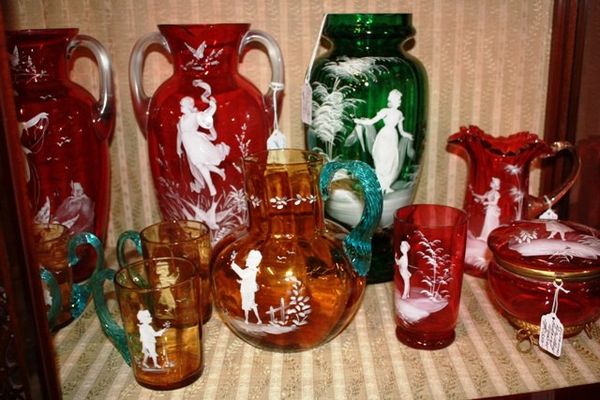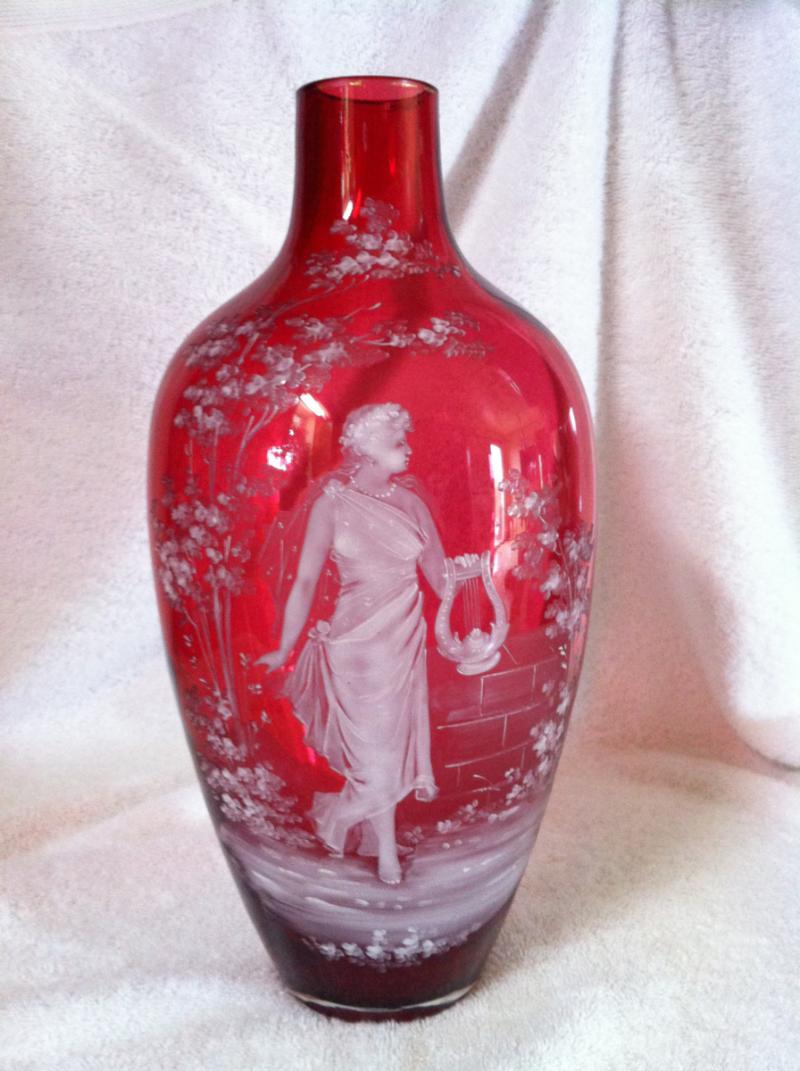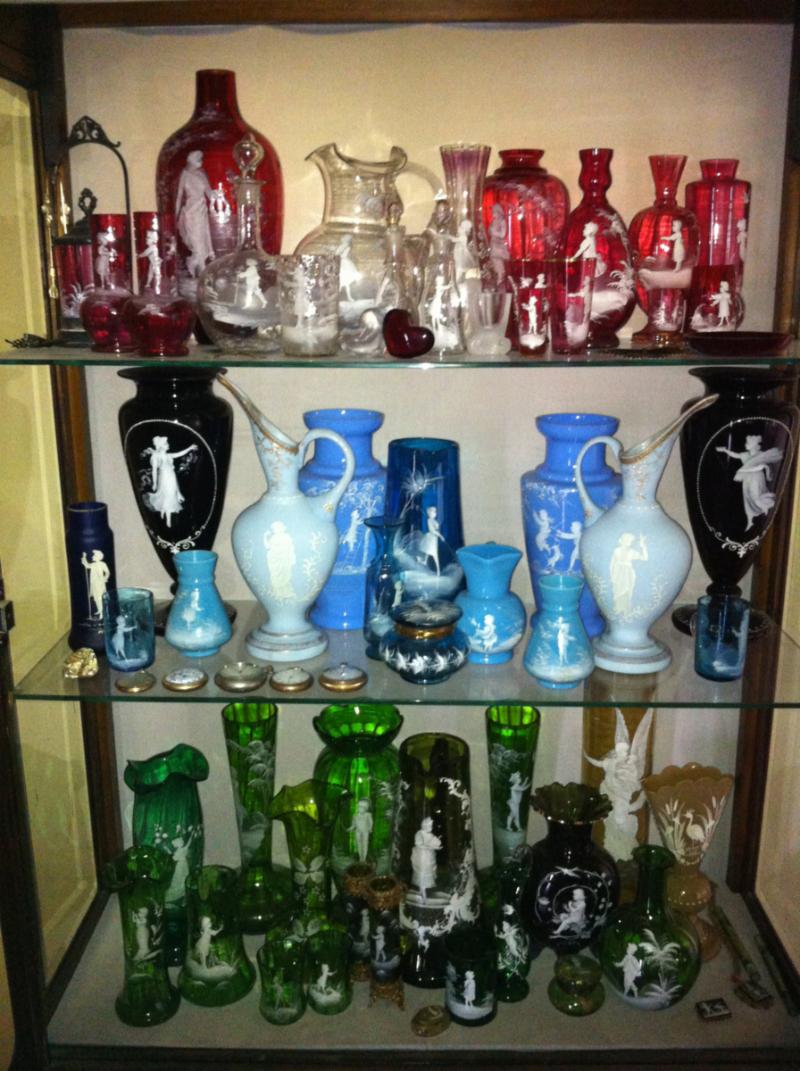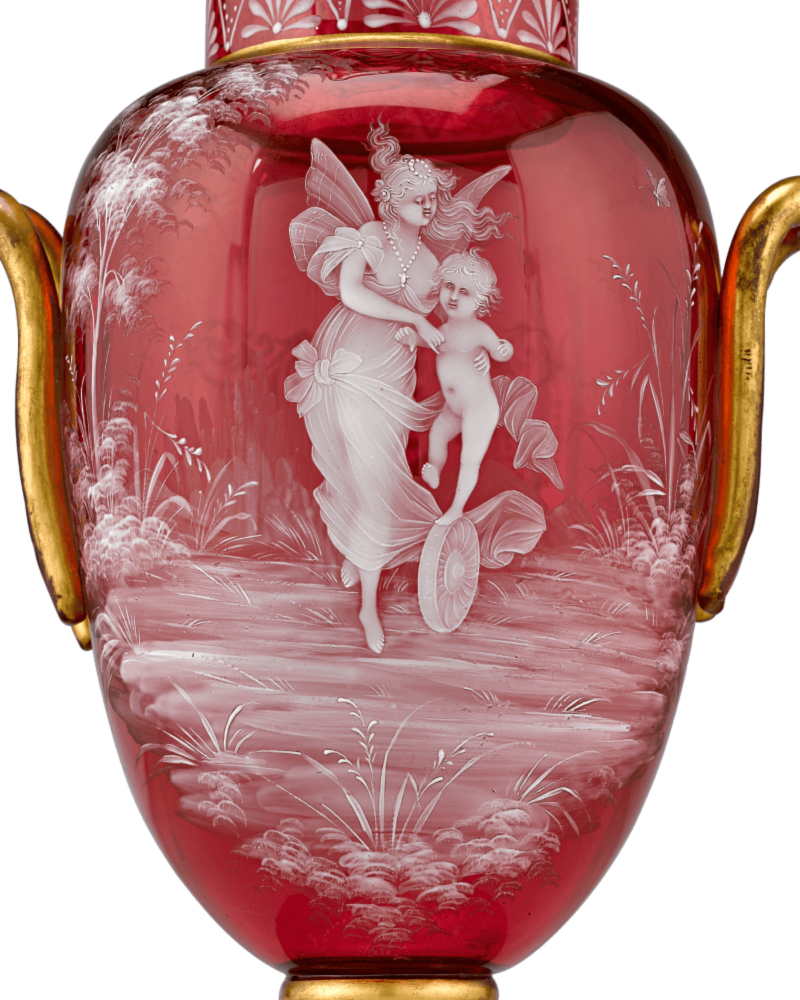|
The Next Tanners Antique Show is
August 4th and 5th
|
Thank you everyone for a fun and Successful April show. We had a lot of wonderful vendors and a very good crowd.
The next show is August 4th and 5th. If you haven't signed up to be a vendor please do it right away.
Vendors, A display case rental company has approached me about renting display cases to vendors. Dan Nopanen has nice oak 4x6 ft by 20" cases as well as jewelry display cases available for about $150 each for the show. He is willing to do it if at least 4 cases are rented. He said they are all nice with LED lighting. You can see examples at octagonoak.com.
Please let me know right away if you are interested.
We have another very good show for you this month! Some new vendors that have never done our show plus most of your favorites.
We also have some Steampunk, recycling and handcraft vendors with their Fun and Creative items and specialty Foods. Bring a can of food for Evelyn Mounts Community Outreach, show this email or print the coupon at the end and get $1.00 off your admission.
Plus we have FREE PARKING!
We are constantly striving to improve the shows so if you have any ideas please let one of us know.
A fun use for old bedsprings
Happy Spring!
Below is the schedule of upcoming
shows
Oct. 6th and 7th
Nov. 17th and 18th
Magic of Santa Craft Faire Dec. 1,2
I'm sorry if any of the dates conflict with other shows,
I do my best to work around them
I'm also constrained by available dates at the Events Center
Please remember to shop at our show and small local stores for unique gifts. The antique stores I list here and places like the Buy Nevada First store in the Reno Town Mall are excellent places to shop and it helps your LOCAL neighbors.
To ensure you get our emails please add our 'From Address' in your address book, trusted sender list or approved sender list
(whatever the name may be in your email client).
It is dan@antique-antics.com
|


GlassEncyclopedia.com:
"Mary Gregory" glass can be divided into old Mary Gregory (made between 1879 to 1939) which was mostly mouth blown and appears to have come primarily from central Europe; and new Mary Gregory glass made after the second world war all over the world, and still made today.
The distinguishing feature of Mary Gregory glass is the stylised white enamel painting usually of a child in an outdoor setting, playing with such things as butterfly nets, bubbles, fishing rods, or hoops. The trees and foliage often have a typical "feathered" style, the figure is oddly old-fashioned in its proportions, and the enamel is fired onto the glass.
This kind of decoration developed from the "painted cameo" glass produced in Europe after about 1870 which itself was developed to compete with the very popular carved cameo from England. Some very beautiful classical scenes in white enamel on Victorian glass are sometimes called "Mary Gregory" glass as the alternative "painted cameo" is not a popular name.
Old Mary Gregory glass is often in the characteristic Victorian colors of cranberry, or bottle green or clear. The quality of the painting is often higher than modern versions, with "double fired" highlights on key features and around the edges of the clothing. The quality of the glass may be thinner and poorer than some of today's Mary Gregory glass, and it is almost always mouth blown. There is rarely any color other than white in the painting, although some post-war Mary Gregory pieces have crude dark lines to emphasize mouth, nose and eyes, and dark hair. There are even Mary Gregory pieces with flesh-colored faces.
Once you have seen a few pieces of Mary Gregory glass you will recognise it easily. It can be difficult to date (see our list of tips below). The easy part is defining what Mary Gregory glass looks like and how to recognise it. The hard part is saying who made it and where.
For a long time it was believed that Mary Gregory glass was produced by the Boston and Sandwich Glass Company, USA, and painted by a decorator called Mary Gregory who was employed by the company in the 1880's. This story began in the 1920's when the name Mary Gregory Glass was first coined. Extensive research has revealed that although there was a decorator of this name working for the Boston and Sandwich Glass Company at that time, Mary Gregory glass was never made by that company.
The "Mary Gregory" designs originated in Europe, probably in Bohemia some time before 1880. Old catalogues of some Bohemian and German glassworks show these designs.
New Mary Gregory glass is still being made in Europe and in the USA and possibly in other glass producing countries.The Westmoreland Glass Company in the USA introduced "Mary Gregory" designs on pressed glass from 1957 until they closed in 1984. The Jeanette Company in the USA has been producing "Mary Gregory" glass since 1982. Their pieces are also pressed glass. Fenton Art Glass Company in the USA has also produced some fine pieces with painted cameo decoration, some of it in Mary Gregory style.
Mary Gregory-style decoration is no guarantee that a piece is old. It can be very difficult to be sure that a piece is old, so we have put together the following list of tips for dating Mary Gregory glass. There are even cases of genuine Victorian glass having a Mary Gregory decoration added later with the aim of increasing it's value, and these are very difficult to detect.
Tips for deciding if Mary Gregory glass is old or new/post World War 2
- provenance: a reliable history of who owned the piece and when it was bought, supported by documents
- wear: genuine wear on the base of a piece indicates age (but not scratches that could have been added deliberately)
- colour: certain colours are very typical of Victorian pieces, like the bottle green colour of the barber bottle above left. Cranberry (pink) and turquoise blue and clear glass are also fairly typical colours for old Mary Gregory glass.
- figures: Victorian Mary Gregory figures of children are distinctive and unlike a modern picture of a child. They have large heads and short arms. Modern Mary Gregory glass often has the same style of figures, but if the painting looks modern or realistic, then it is unlikely to be old Mary Gregory glass.
- shape: sometimes the shape of a piece or other design features like the rim suggest a Victorian origin, but these have been copied.
- pressed or blown glass: Mary Gregory decoration on pressed glass was introduced in the 1950's; virtually all old Mary Gregory glass is blown glass and has a pontil mark on the bottom
- quality of enamelling: some old Mary Gregory glass had high quality enamelling which is rare on post-war pieces. This included double firing or even multiple firing the enamel so that greater variation in the thickness was acheived. This made it more similar to cameo glass. Double firing was often used on old Mary Gregory glass to apply highlights to key points and to add emphasis to the edges of clothing.
- quality of the glass: modern glass tends to be higher quality, more perfect, than old glass.
- color in the enamel: there was a source of post-war Mary Gregory which produced enameling with color added, either as dark lines for emphasis or flesh colors for faces or dark colored hair. These features are unlikely to be found on old Mary Gregory glass.
It will be clear that you need to take all of these things into consideration when making your judgement, and even then it is very easy to make a mistake because the old features may be copied onto contemporary pieces or even onto old pieces, largely because of the high prices paid for Mary Gregory glass by collectors.
The value of Mary Gregory glass is affected by the color of the glass. Colors ranked by antiquelegacies.com from least expensive to most expensive are: clear, clear with amethyst, dark green, light green, amber, light blue, turquoise, cobalt blue, ruby or cranberry. Extremely rare pieces are champagne- or amethyst-colored glass.
Real or Repo.com:
The end of WW I brought numerous changes to the Czech glass houses, but the during the period after WW II they were completely reorganized.
Then in 1947, the Communist Party took power in Czechoslovakia. By 1951, the Communists had nationalized every glass factory and expelled everyone of German ancestry which included thousands of glass decorators. Fortunately most of the glass makers were native Czechs and Slovaks and production of undecorated glass could continue. Committees were set up to run the glass industry with all the glass factories united under the single name of Crystalex. The name Glassexport was used for the organization which would market the glass through world wide offices.
As production resumed, one of the first types of decorations produced was "Mary Gregory." Painting Quarkmal, which translates from the German as "white people," was not a simple task. In years past, German decorators had the benefit of many generations of father-to-son training and many persons started painting by the age of ten. The post-war decorations were not as well done as pre-war decorations and over time the differences in quality became more and more obvious.
To speed production, standard designs were simplified and the variety of designs available was greatly reduced. Occasionally custom orders were processed that required more skill and time. The decorators were also often called upon to create paintings that would pass as "old."
For several years after the war, the shortage of raw materials forced the glass houses to produce mostly clear glass of mediocre quality. Most cranberry glass of this period is actually clear glass with only a cranberry stain or flashing. By 1960, the quality of the glassware improved and solid red and blue glass was back in wide use. Even as the glass itself improved, however, the quality of decoration continued to decline.
The oldest and finest decorations were previously done over a period of several days. Usually the entire figure would be painted and allowed to dry. Details were then added to the piece and it was fired with all the white-on-white lines flowing together. In many pieces, small details called points would be added and the piece fired a second time. These points stand out vividly even though the decoration is entirely white-on-white. (Fig. 6)
A second firing is naturally more costly than a single firing and since 1945 it has been nearly abandoned. The search for ways to lower production costs eventually lead to what is called the take away method of painting. Instead of emphasizing details by adding paint such as raised lines or points, the take away method creates details by removing paint. The lack of white-on-white detail is a definite indication of postwar glass, but the presence of white-on-white decoration is no guarantee that the piece is pre-war. (see Figs. 7&8)
By 1970, Czechoslovakian artists and engravers had re-established themselves as world class glass decorators. They had little interest or desire to recreate the past. Crystalex continues to process orders for "Mary Gregory" glassware, but on a limited basis and offers a relatively small selection of subjects.
Although "Mary Gregory" glassware was primarily a Czech product, it was not entirely limited to the Bor Region of Czechoslovakia. Switzerland, Holland and Germany also produced glassware of this type. In the postwar years, American importers have been willing to purchase Mary Gregory glassware anywhere if the price was right.
The history of this type of glassware would not be complete without including some reference to the American decorators who also worked in this style. In 1957, Robert Rupp was Vice President and General Manager at Westmoreland Glass Company in Grapeville, Pennsylvania. His staff of decorators included two brothers, Edward and Edmond Pohl. The Pohls, being of German ancestry, were forced to leave post-war Czechoslovakia and had come to the United States by way of South America. The Pohls were experienced "Quarkmanl" painters and worked with Rupp to create a series of "Mary Gregory" decorated glassware.
Westmoreland launched their "Mary Gregory" line on an 8" plate with pierced forget-me-not border (Fig. 15). The Mary Gregory decorations were successful and by the time Westmoreland closed in 1984, there was a great variety of glassware available with the white enamel decorated figures.
With the closing of Westmoreland, many of their decorators turned to free lancing for private glass wholesalers who contracted with glass makers to reproduce the Westmoreland line. In 1982, Rupp left Westmoreland and opened "Treasured Editions" in Jeanette, Pennsylvania. Over the years, he has been joined by several former Westmoreland employees, including former head artist Ernest Brown. They have reproduced many of the Westmoreland products, most notably the #750 basket with a variety of the old Westmoreland Mary Gregory decorations. Other entrepreneurs have also reproduced the Westmoreland line. Phil and Helen Rosso (of Rosso Wholesale Glass) have contracted with former Westmoreland decorators and continue to offer a variety of "Mary Gregory" style glassware.
Experienced collectors of "Mary Gregory" glassware should have no problem separating pre-war glass from post-war pieces. Beginners, however, might benefit from a few general guidelines.
1. Look for well done figures. Very few of the post-war decorations are of high quality.
2. Cased glass was rarely, if ever, produced after 1945. A white lining with a tan, yellow, blue or red outer layer generally indicates pre-war glass,
3. 10 and 12 sided glass (as opposed to perfectly round) is generally pre-war.
4. Cranberry stained glass is typically post-war. Most pre-war cranberry was solid cranberry.
5. Gold trim should show logical and natural wear. Glass with shiny, "good as new" trim is probably new.
6. Note the method of how the enamel was applied-- is it white-on-white or "take-away". White-on-white may be post-war, but take-away paintings are allpost-war.
7. Most tableware is post-war. Pre-war sugar shakers, syrups, cruets, etc., are scarce and would have only highly detailed paintings of excellent quality.
Mary Gregory worked for the Boston & Sandwich Glass Co. as a glass decorator from 1880 to 1884. Legend has it that she created a line of glass featuring handpainted scenes of Victorian children at play. Using a white enamel paint containing ground glass as a mixture, the art was applied to the glasses then fired, with an additional firing after each layer of the white-on-white buildup.
However, extensive research after her death in 1908 revealed that the decoration known as Mary Gregory was not produced in this country before 1957, according to antiquelegacies.com. It is believed to have started in the mid-19th century in Europe. Even so, the Mary Gregory name stuck and the beautiful style of handpainted glass remains popular today.
The widespread belief that the Boston and Sandwich Glass Company and other American glass houses produced Mary Gregory glass has undoubtedly increased American interest and prices for this type of glassware. Now that the facts have come to light, I believe a period reevaluation will follow. Historically, when new information on a specific antique becomes available, prices for that antique rise. In the case of Mary Gregory glassware, I feel the opposite may be true--at least for items near the bottom of the scale in quality and for items made since 1945.
Robert Truitt is the author of the book Mary Gregory Glassware.



Please visit the web pages below for more information:
Glass Encyclopedia -
http://www.glassencyclopedia.com/Marygregoryglass.html
|
|
Save $1.00
off Show Admission
|
Bring this Coupon or a can of food for Evelyn Mounts Community Outreach and get $1.00 off your
Admission!
|
|
|
|
Places to Stay:
Ramada Reno Hotel and Casino, (Tanners Host Hotel)
1000 East 6th Street, Reno, NV 89512, 775-786-5151
Ramada Website
Click Here To See The Ramada Special Offer
The Ramada will reserve a block of rooms for us at a greatly discounted rate of $50 per night plus taxes.
To book your rooms, Please call the hotel directly at 775-786-5151
and ask for the Hotel Desk. The booking company doesn't know about the discounts.
Please call in advance.
Motel 6 Reno Livestock Events Center, 866 North Wells Avenue, Reno, NV 89512, 775-786-9852
I-80 at N Wells Avenue, Exit #14,
Motel 6 Reservations
Days Inn Reno, 701 East 7th Street, Reno, NV 89512, 775-786-4070
DaysInn.com
Sands Regency Casino, 345 N. Arlington Avenue, RENO, NV 89501, 775-348-2200
SandsRegency.com
|
|
|
Let's make this a fun forum to keep interest and excitement up for the shows!
Sincerely,
Dan and Paula Clements
Tanners Marketplace
P.O. Box 618, Fernley NV 89408
775-741-9524
|
|
|
|
Let your Friends Know
Forward this Newsletter to your friends to let them know about the show.
Suggest they sign up for their own newsletter by joining our Mailing List.
|
|
The list will only be used for Tanners emails and not sold etc. |
|
At the Livestock Events Center
Tanners Marketplace :
January 27th and 28th
A
pril 21st and 22nd
November 17th and 18th
Magic Of Santa:
December 1st and 2nd
|
Please Visit the Somewhere In Time antique mall at 1313 S. Virginia St.
(Paula and Dan are there on Mondays)
|
|
Weekly Auctions
Auctions by Sammy B
|
 |
|
A Fun Antiques and Clothing Store
|
|
|
https://www.facebook.com/vsamreno
|
|
The above vendors are listed as a local resource.
They have not paid to be featured.
|
|
Spring Jokes
Why is a traffic light red?...
You would be red too if you were changing in front of people all day.
Did I tell you the joke about the ceiling?...
Oh forget it. It's over your head.
What do you call cheese that is not yours?...
NACHO cheese!
Where does a fish go to borrow money?...
The loan shark!
Teacher: Johnny, what are the last words of "The Star-Spangled Banner"?...
Johnny:"Play ball"?
What did King George think of the American colonists?...
He thought they were revolting!
Why don't mummies go on summer vacation?...
They're afraid to relax and unwind!
First woman: My son came to visit for summer vacation.
Second woman: How nice! Did you meet him at the airport?
First woman: Oh, no. I've known him for years!
Teacher: Johnny, please use the words "letter carrier" in a sentence.
Johnny: Yes, ma'am. "My dad said that after seeing how many things my mom was bringing on vacation, he would rather letter carrier own luggage."
First dog: Where do fleas go for summer vacation?
Second dog: Search me!
Myles: Why didn't the elephant buy a suitcase for his vacation?
Henry: Why?
Myles: Because he already had a trunk!
With the rise of self-driving vehicles, it's only a matter of time before we get a country song where a guy's truck leaves him too.
Two blondes were driving to Disneyland. The sign said, "Disneyland Left". So they started crying and went home.
What's worse than raining cats and dogs? Hailing Taxi's.
I applied for a job today and they asked for three references. I wrote, "a dictionary, a Thesaurus, and a map."
I got excited when my son joined the cross-country team.
But then I learned they don't cross the country and are back home in a few hours.
What goes through towns, up hills, and down hills but never moves?
The road!
I read a survey that said 82% of people enjoy being cuddled. But if the people on this bus are any indication, the real figure is, like 0%.
Ladies dating a short guy is fun until you can't find him at the club and you don't have taxi money to go home.
For me, being "clean and sober" means I'm showered and headed to the pub.
My wife told me: "Sex is better on holiday."
That wasn't a very nice postcard to receive.
Teacher: More than 200 years ago, our forefathers defeated the British in the Revolutionary War.
Caleb: Wow! They must have been pretty strong, four men defeating a whole army!
Why did the duck say bang?
Because he was a firequacker.
"Well," snarled the tough old General Cornwallis to the bewildered soldier. "I suppose after you get discharged from the army, you'll just be waiting for me to die so you can come and piss on my grave." "Not me, General!" the soldier replied. "Once I get out of the army, I'm never going to stand in line again!"
There was one little boy in the teacher's class who really struggled to learn.
One day the teacher asked him who signed the Declaration of Independence, and of course he didn't know. The teacher asked him every day for a week but still he couldn't give the right answer.
Finally, in desperation, she called the boy's father to come and see her. She said to him, "Your boy won't tell me who signed the Declaration of Independence."
The father said to his son, "Come here, boy, and sit down."
The boy duly did as he was told and then his dad said to him, "Now if you signed that stupid thing, just admit it so we can get out of here."
What did one firecracker say to the other firecracker?
My pop's bigger than your pop.
People have forgotten what 4th of July really is about. Today it commemorates the freedoms we use everyday. It's not fireworks and parties. That's just what makes it fun.

|
|
|